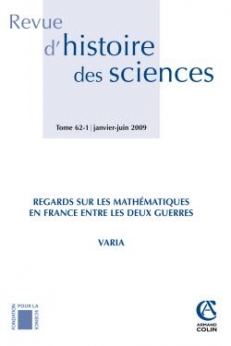
Revue d'histoire des sciences - Tome 62 (1/2009)
Pour acheter ce numéro, contactez-nous
Recevez les numéros de l'année en cours et accédez à l'intégralité des articles en ligne.
La collaboration entre mathématiciens français et russes commence pendant la première décennie d’activité de l’Académie des sciences de Saint-Pétersbourg. Elle se renforce au xixe siècle (rappelons les débuts de carrière de Mikhail V. Ostrogradskii et Viktor Ya. Bunyakovskii, les contacts de Pafnutii L. Chebyshev avec Charles Hermite et d’autres mathématiciens français, la correspondance de Henri Poincaré avec Aleksandr M. Lyapunov) et devient un facteur important de l’éclosion de la pensée mathématique au xxe siècle. La base de cet essor fut posée par l’école de Moscou de la théorie des fonctions, fondée par Dmitrii F. Egorov et Nikolai N. Luzin pendant les années 1910. Apparue comme la branche russe de l’école française de la théorie des fonctions d’une variable réelle (Émile Borel, René Baire, Henri Lebesgue), cette école trouva ses propres sujets originaux (Luzin, Dmitrii E. Men’shov, M. Ya. Suslin, Aleksandr Ya. Khinchin, Pavel S. Aleksandrov) et acquit un développement exceptionnel (Andrei N. Kolmogorov, Lev S. Pontryagin et les autres) en élaborant (avec l’école de Saint-Pétersbourg/Léningrad) les fondements de l’école mathématique soviétique. L’intensification de la collaboration franco-russe, sur fond de poursuite de ce processus de recherche mathématique, suivit le chemin de la théorie des fonctions d’une variable réelle et des axes de recherche liés à celle-ci (comme la théorie des probabilités à cette époque), s’orientant aussi vers d’autres domaines, telles différentes branches de l’analyse mathématique, de la géométrie différentielle et autres (Élie Cartan, Jacques Hadamard, Sergei N. Bernshtein, Paul Lévy, outre les savants déjà nommés). Les événements qui précédèrent la deuxième guerre mondiale mirent fin à ce processus. Et si on vit renaître la collaboration internationale en mathématiques dès la fin de la guerre, les mathématiciens soviétiques ne purent y prendre part qu’une dizaine d’années plus tard, après la mort de Staline, quand s’acheva la guerre froide ; en témoigne le cycle de cours donnés par Kolmogorov à l’Institut Henri Poincaré, en 1958.
The collaboration between French and Russian mathematicians began during the first decade of activity of the Saint Petersburg Academy of Science. It strengthened during the 19th century (let us recall the early carriers of Mikhail V. Ostrogradskii and V. Ya. Bunyakovskii, Pafnutii L. Chebyshev’s contacts with Charles Hermite and other French mathematicians, Henri Poincaré’s correspondence with Aleksandr M. Lyapunov) and became an important factor in the blossoming of 20th century mathematical thought. The groundwork for this growth was laid by the Moscow school of the theory of functions, founded by Dmitrii F. Egorov and Nikolai N. Luzin during the 1910s. Originating from the Russian branch of the French school of the theory of functions of a real variable (Émile Borel, René Baire, Henri Lebesgue), this school formulated its own original topics (Luzin, Dmitrii E. Men’shov, M. Ya. Suslin, Aleksandr Ya. Khinchin, Pavel S. Aleksandrov) and flourished (Andrei N. Kolmogorov, Lev S. Pontryagin and others) setting the foundations of the Soviet mathematical school (with the Saint Petersburg/Leningrad school). The strengthening of Franco-Russian collaboration, in this context, followed the path of the theory of functions of a real variable and the directions of research associated with it (such as the theory of probability at the time). But it also led into new areas, such as different branches of mathematical analysis, differential geometry and so forth (Élie Cartan, Jacques Hadamard, Sergei N. Bernshtein, Paul Lévy, in addition to the scientists already mentioned). The events that preceded the Second World War brought this line of development to an end. Right after the war international collaboration started again, but Soviet mathematicians could take part only a decade later, after Stalin’s death, when the Cold War ceased, as is evidenced by the series of conferences given by Kolmogorov at the Henri Poincaré Institute in 1958.